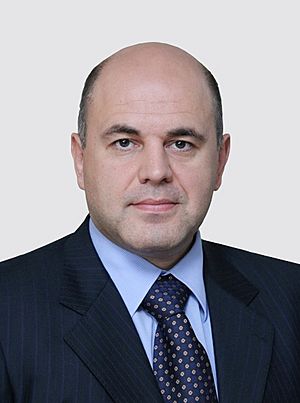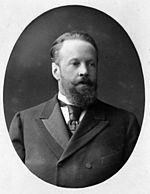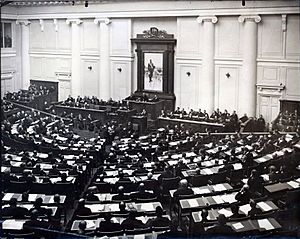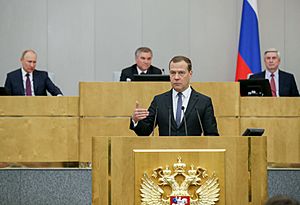Prime Minister of Russia facts for kids
Quick facts for kids Prime Minister of the Russian Federation |
|
|---|---|

|
|

Logo of the Government of Russia
|
|
| Executive branch of the Russian Government Council of Ministers of Russia |
|
| Style |
|
| Abbreviation | PMOR, PMORF |
| Member of |
|
| Reports to | |
| Seat | White House, Moscow |
| Nominator | President |
| Appointer | President
(with the approval of the State Duma)
|
| Term length | No fixed term |
| Constituting instrument | Constitution of Russia |
| Precursor | Chairman of the Council of Ministers of the Soviet Union (1923–1991) |
| Formation |
|
| First holder | Sergei Witte |
| Deputy | |
| Salary | US$105,000 annually |
| Website | (geo blocked) |
The Prime Minister of the Russian Federation is the head of government in Russia. This means they are in charge of the country's government and its daily operations. In Russia, this role is officially called the Chairman of the Government of the Russian Federation. It is the second most important political job in Russia, right after the President.
Even though the Prime Minister leads the government, the President of Russia has a very strong role. The President chooses and can remove the Prime Minister and other government members. The President can also lead government meetings and give orders. The current Prime Minister is Mikhail Mishustin. He was appointed on January 16, 2020.
Contents
History of the Prime Minister Role
Early Leaders in Imperial Russia
Before 1905, the Emperor of Russia was the main leader of the government. Ministers reported directly to him. In 1810, a special chairman role was created for the State Council of Imperial Russia. This position was often given to older, respected officials.
The First Modern Prime Ministers (1905–1917)
The modern role of Prime Minister began in 1905. Emperor Nicholas II of Russia created the Council of Ministers of the Russian Empire. This group brought all the ministers together into one cabinet. The Chairman of this Council became the official head of government. Nicholas II appointed Sergei Witte as the first "Prime Minister."
From 1905, the Prime Minister gained significant power. They could create their own policies and reforms. Pyotr Stolypin, who was Prime Minister from 1906 to 1911, was known for making big changes.
The Russian Constitution of 1906 created the State Duma, which was like a parliament. However, the government did not have to answer to the Duma. There were often disagreements between the Duma and the government. The role of Chairman of the Council of Ministers lasted for 12 years. It ended after the February Revolution in March 1917.
Provisional Government (1917)
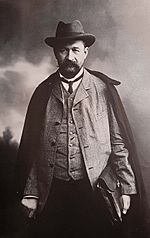
After the Emperor stepped down in 1917, a new group called the Russian Provisional Government took over. The leader of this government was called the "Minister-Chairman." Only two people held this job: Georgy Lvov and Alexander Kerensky. This government lasted about six months. After the October Revolution, the role changed to Chairman of the Council of People's Commissars.
Soviet Era (1917–1991)
During the Soviet period, the head of government was first called the Chairman of the Council of People's Commissars. Later, in 1946, this role was renamed Chairman of the Council of Ministers. People in these positions are often referred to as Prime Ministers or Premiers.
Post-Soviet Russia (1991–Present)

Today, the Prime Minister's official title is "Chairman of the Government of the Russian Federation". The President of Russia appoints the Prime Minister. The State Duma (Russia's parliament) must agree to the appointment. The Prime Minister reports to the President regularly. They also report to the State Duma once a year.
After the Soviet Union ended, Boris Yeltsin became the first President of Russia. For a short time, he also led the government himself. Later, Viktor Chernomyrdin became the first official Chairman of the Government.
Sometimes, a "technical prime minister" is appointed. This is a Prime Minister who is not a strong political leader on their own. Instead, the President is the real leader of the government's activities.
What the Prime Minister Does
The Prime Minister mainly handles the day-to-day running of the government. They help carry out the policies set by the President. Here are some of their main duties:
- They decide the government's main goals and organize its work.
- They suggest how the government's departments (like ministries) should be set up.
- They propose who should be Vice Prime Ministers and federal ministers to the President.
- They represent the government both in Russia and with other countries.
- They lead government meetings and have the final say in votes.
- They sign official government decisions.
- They report to the State Duma every year about the government's work.
- They give tasks to other government members.
- They keep the President updated on what the government is doing.
The Prime Minister is also automatically a member of several important groups. These include the Security Council of Russia and councils for international organizations like the Commonwealth of Independent States.
How a Prime Minister is Chosen
In the past, the Emperor chose the Prime Minister without needing approval from the Duma. During the Soviet era, the Supreme Council appointed the Prime Minister.
Today, the President of Russia chooses a candidate for Prime Minister. The State Duma then has to approve this choice. Unlike many other countries, the Russian Prime Minister does not have to be an elected member of parliament. They just need to be a Russian citizen.
The President must name a new Prime Minister candidate within two weeks after a government resigns or a new President takes office. The State Duma then has two weeks to discuss and vote on the candidate. If the Duma approves, the President can officially appoint the Prime Minister.
If the State Duma rejects the candidate, the President must propose another candidate within one week. If the Duma rejects the President's choice three times in a row, the President can dissolve (close down) the Duma. Then, new elections are called, and the President can appoint a Prime Minister without the Duma's approval. However, the Duma cannot be dissolved in its first year, during the last six months of the President's term, or during emergencies or war.
Leaving the Job
The President can dismiss the Prime Minister at any time. The Prime Minister can also choose to resign. However, the President can refuse their resignation and ask them to continue working. The Prime Minister and the entire government must resign when a new President takes office. The President can then choose to dismiss the whole government or just the Prime Minister.
The State Duma can also try to force the Prime Minister and government to resign. This happens if the Duma votes against the government (a "censure motion") twice within three months. If this happens, the President usually has to choose between firing the government or dissolving the Duma. However, if it's within the first year after parliamentary elections, the President must dismiss the government.
How Long They Serve
In the past, there was no set time limit for how long a Prime Minister served. They stayed in the job as long as the Emperor or the leader of the Communist Party wanted them to.
After the role of President of Russia was created, the Prime Minister's term became linked to the President's. The Prime Minister must resign when a new President is sworn in, but they can be appointed again. From 1991 to 1996, the maximum term was 5 years. After the new Constitution of Russia in 1993, it became 4 years. In 2012, changes to the Constitution increased the term for both the President and Prime Minister to 6 years.
Acting Prime Minister
If the Prime Minister is temporarily away, one of the Deputy Prime Ministers takes over their duties. This happens automatically. There is no time limit for how long someone can be an "acting" Prime Minister in this situation.
If the Prime Minister resigns, the entire government also resigns. The President can then ask one of the Deputy Prime Ministers to be an acting Prime Minister. This temporary role can last up to two months. This time allows the President to choose a new candidate for Prime Minister and get approval from the State Duma. Often, the acting Prime Minister is later proposed as the new Prime Minister.
What Happens if the President Can't Serve
If the President dies, resigns, or is removed from office (impeached), the Prime Minister becomes the temporary President. This temporary role lasts until new presidential elections can be held, which must happen within three months. As acting President, the Prime Minister cannot dissolve the State Duma, call for a national vote (referendum), or propose changes to the Constitution.
The Russian Constitution does not clearly state who would become acting President if both the President and Prime Minister are unable to serve.
List of Heads of Government Since 1991
Since 1991, Russia has had several heads of government. The current Prime Minister, Mikhail Mishustin, took office on January 16, 2020.
See also
 In Spanish: Presidente del Gobierno de Rusia para niños
In Spanish: Presidente del Gobierno de Rusia para niños


